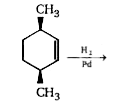Which of the following reaction will not form racemic mixture as product?




The correct Answer is:B
To determine which reaction will not form a racemic mixture, we need to analyze each reaction and identify whether the product contains a chiral center. A racemic mixture is formed when a reaction produces a chiral compound that can exist in two enantiomeric forms.
1. Understanding Racemic Mixtures:
- A racemic mixture consists of equal amounts of two enantiomers (mirror-image isomers). For a compound to be chiral, it must have four different substituents attached to a central carbon atom.
2. Analyzing Reaction A:
- The reaction involves a carbonyl compound reacting with HCN to form a cyanohydrin.
- The carbon atom that is formed during this reaction becomes chiral because it has four different groups attached to it (CH3, CH2, CN, and OH).
- Conclusion: Reaction A will form a racemic mixture.
3. Analyzing Reaction B:
- The reaction involves a compound with two identical methyl groups reacting with HCl.
- The resulting carbocation has two identical groups (the two methyl groups), which means the carbon is not chiral.
- Conclusion: Reaction B will not form a racemic mixture.
4. Analyzing Reaction C:
- The reaction involves a cyclohexane ring with a double bond and a methyl group reacting with HCl.
- The formation of a tertiary carbocation occurs, which is chiral due to having four different groups attached (methyl, hydrogen, chlorine, and the rest of the cyclohexane).
- Conclusion: Reaction C will form a racemic mixture.
5. Analyzing Reaction D:
- The reaction involves butene reacting with HBr.
- A secondary carbocation is formed, which can also lead to a chiral center being formed depending on the attack of bromine.
- The resulting product has four different groups attached to the chiral carbon.
- Conclusion: Reaction D will form a racemic mixture.
Final Answer:
The reaction that will not form a racemic mixture is Reaction B.
- A racemic mixture consists of equal amounts of two enantiomers (mirror-image isomers). For a compound to be chiral, it must have four different substituents attached to a central carbon atom.
- The reaction involves a carbonyl compound reacting with HCN to form a cyanohydrin.
- The carbon atom that is formed during this reaction becomes chiral because it has four different groups attached to it (CH3, CH2, CN, and OH).
- Conclusion: Reaction A will form a racemic mixture.
- The reaction involves a compound with two identical methyl groups reacting with HCl.
- The resulting carbocation has two identical groups (the two methyl groups), which means the carbon is not chiral.
- Conclusion: Reaction B will not form a racemic mixture.
- The reaction involves a cyclohexane ring with a double bond and a methyl group reacting with HCl.
- The formation of a tertiary carbocation occurs, which is chiral due to having four different groups attached (methyl, hydrogen, chlorine, and the rest of the cyclohexane).
- Conclusion: Reaction C will form a racemic mixture.
- The reaction involves butene reacting with HBr.
- A secondary carbocation is formed, which can also lead to a chiral center being formed depending on the attack of bromine.
- The resulting product has four different groups attached to the chiral carbon.
- Conclusion: Reaction D will form a racemic mixture.
The reaction that will not form a racemic mixture is Reaction B.
Similar Questions
Knowledge Check
Which of the following reaction will give racemic mixture?
A B
B C
C D
D
A racemic mixture is :
Aalways equimolar mixture of a pair of enantiomersBalways equimolar mixture of a pair of diastereomersCalways optically inactiveDalways optically activeProduct of which of the following reactions, is racemic mixture ?
A B
B C
C D
D
Which of the following compounds will give racemic mixture on nucleophillic substitution by OH− ion?

View SolutionIn which fo the following reactions is the correct major product formed?
View SolutionWhich one of the following products would produce a racemic
mixture on monochlorination ?
I.
View SolutionIn which of the following reactions product formed is same ?

View SolutionWhich of the following compounds will give racemic mixture by SN1 reaction?
View Solution
